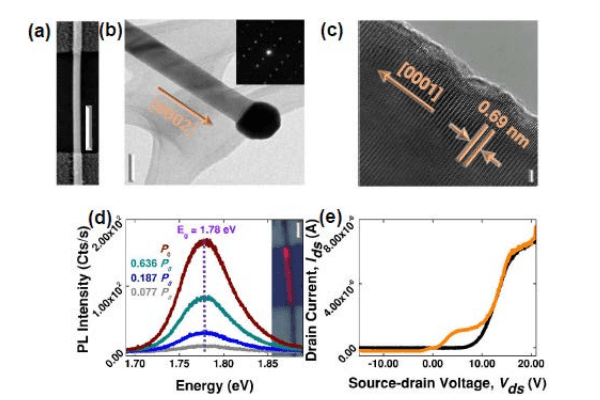Jason Marmon

Jason Marmon

Light-matter interactions in semiconductor nanowires: Light-effect transistor and light-induced changes in electron-phonon coupling and electrical characteristics
Abstract:
This dissertation explores three related embodiments of light–matter interactions at the micro– and nano–scales, and is focused towards tangible device applications. The first topic provides a fundamentally different transistor or electronic switch mechanism, which is termed a light–effect transistor (LET). The LET, unlike exotic techniques, provides a practical and viable approach using existing fabrication processes. Electronic devices at the nanoscale operate within the ballistic regime, where the dominate source of energy loss comes from impurity scattering. As a LET does not require extrinsic doping, it circumvents this issue. Electron–phonon coupling, however, is the second largest source, and it is a pertinent and important parameter affecting electronic conductivity and energy efficiency, such as in LETs. The third topic is laser writing, or the use of a laser to perform post–growth modifications, to achieve specific optical and electrical characteristics.
A LET offers electronic–optical hybridization at the component level, which can continue Moore’s law to the quantum region without requiring a FET’s fabrication complexity, e.g., physical gate and doping, by employing optical gating and photoconductivity. Multiple independent gates are therefore readily utilized to achieve unique functionalities without increasing chip space. LET device characteristics and novel digital and analog applications, such as optical logic gates and optical amplification, are explored. Prototype cadmium selenide (CdSe) nanowire–based LETs show output and transfer characteristics resembling advanced FETs, e.g., on/off ratios up to ~1.0×10 6 with a source-drain voltage of ~1.43 V, gate-power of ~260 nW, and a subthreshold swing of ~0.3 nW/decade (excluding losses). The LET platform offers new electronic–optical integration strategies and high speed and low energy electronic and optical computing approaches.
Electron–phonon coupling is typically studied as an intrinsic property, which is particularly important for electronic transport properties at the nanoscale, where controversy and even contradictory experimental and theoretical findings still persist. Zinc telluride (ZnTe) has important uses in optical or laser refrigeration, and the existing studies do not consider extrinsic effects, such as laser–forming tellurium–based species. Nanostructures, with their large surface–to–volume ratios, are more susceptible to extrinsic perturbations that ultimately effect coupling. In this dissertation, ZnTe is studied in bulk, thin film, and nanowire forms with primary focus on the latter. Raman spectroscopy under near resonant excitation is used to extract electron–phonon coupling strengths, which is obtained through the ratio of the first and second order Raman peaks, R = I2LO/I1LO (and is proportional to the Huang–Rhys factor). Laser–formation of tellurium–based species on ZnTe nanowires dynamically altered the ratio R from ~6-7 to 2.4 after laser processing, while tuning the (532 nm) laser power from a few microwatts to 150 microwatts (with constant optical exposure time) did not significantly impact the EPC strength. Other explored effects include size dependence, chemical effects (methanol exposure), and interface effects (e.g., at a gold–nanowire junction). The findings suggest that the previously reported size dependence in ZnTe was extrinsic in nature. Tunable coupling strengths also suggest the possibility of novel electronic and optoelectronic devices.
The electrical characteristic of CdSe nanowire M-S-M devices are shown to be tunable with laser illumination. As with any semiconductor material, sufficiently low optical powers produce stable and reproducible electrical properties, while higher optical powers and exposure times can induce laser modifications of the material. Drastic modification of electrical characteristics were observed, such as from converting an ohmic response (linear slope change) to rectified characteristics, and modification of both forward and reverse currents. Results suggest the potential to laser write wavelength–specific electronic functions that could be used in applications requiring wavelength discrimination, such as with night vision products. Using a combination of laser modification and device fabrication processes provides the ability to offer a menu of electrical behaviors using the same materials and fabrication processes.
Sponsoring Chair: Dr. Yong Zhang
Committee: Dr. Ryan Adams, Dr. Michael A. Fiddy, Dr. Daniel Rabinovich, Dr. Thomas A. Schmedake, Dr. Haitao Zhang